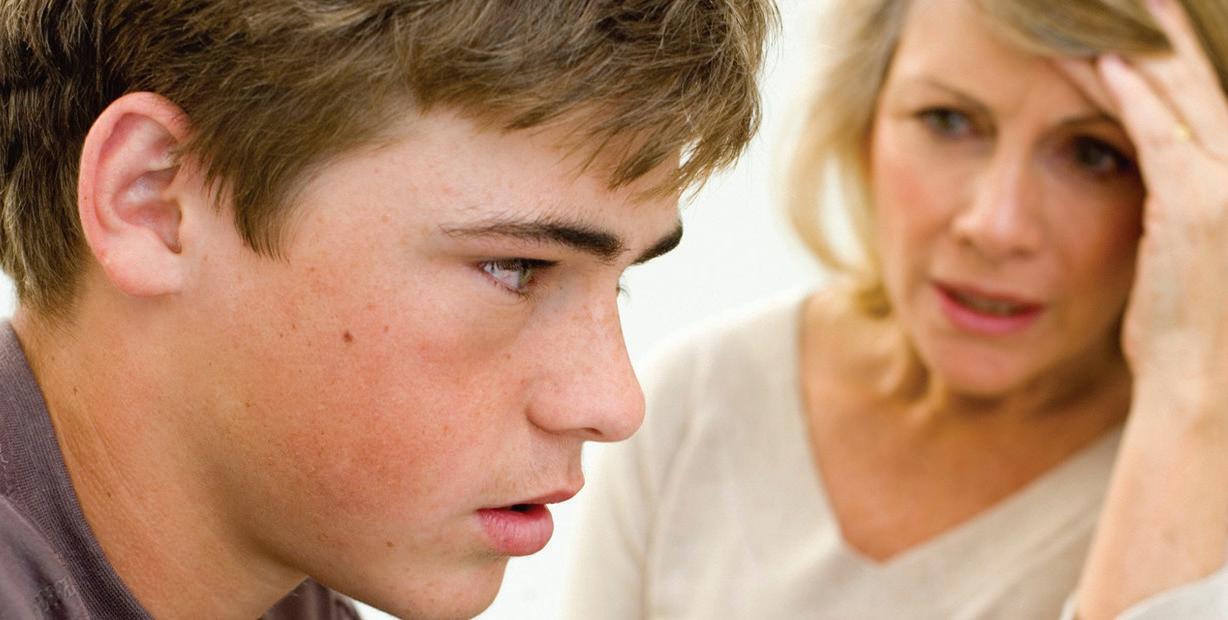
4 minute read
PARENTHOOD
by David W. Proefrock, PhD
Your 10-year-old son simply refuses to keep his room clean. If you don’t check several times a day, you will find old food, half-finished drinks, various toys, and dirty clothes completely covering the floor. You feel like you have tried everything, but he doesn’t seem to mind living in a mess. You end up cleaning his room yourself to prevent your house being condemned by the health department. What do you do?
A. Choose a reasonable consequence and stay with it. For example, if you say no TV or computer until the room is cleaned, make sure that it happens. It may take several weeks to show some improvement.
B. Get him to clean his room when you can, but don’t make a daily battle of it. Come to terms with the possibility that your son might just be a slob.
C. Shut the door to his room and don’t clean it no matter how bad it gets. If you wait long enough, he will get tired of living in a mess and clean it.
D. Tell him that it is his responsibility to clean his room and that if you have to do it for him, you will charge him from his allowance for your time. Hitting him in the wallet might bring him around.
If you answered:
A. This is probably as good a response as any, but remember that you have to be completely consistent for it to work.
B. It could be that this is what you will end up with, but it’s probably better to try some other things before you give up completely.
C. This is what most child psychologists and “experts” recommend, but I have never encountered a parent who could outwait a messy kid. Good luck if you try it.

D. This is a reasonable response and also as good as any. Don’t count too much on it working though.
Messy rooms are probably one of the most difficult things to change when raising a child. Most things don’t work at all and none work very well.
Dr. Proefrock is a retired local clinical and forensic child psychologist.

CRANBERRY JUICE CURES UTIs
Who hasn’t heard this myth? Answer: no one hasn’t. It is one of the standbys of do-it-yourself medicine and natural cures.
Oh, if only it was true.
That’s not to say drinking cranberry juice is harmful, and it’s not to say it might not help just a little bit when it comes to UTIs (urinary tract infections). But anyone who has such an infection wants a definite cure, not a maybe cure.
According to a 2012 review of some two dozen studies of the effectiveness of cranberry juice, it offers just a 14% lower risk of UTI compared to no treatment or placebo, and study authors cautioned that was an especially optimistic number.

And a 2011 European Food Safety Authority examination of the “claim on cranberry fruit products” pertaining to reducing the risk of urinary tract infections in women “has been assessed with an unfavorable outcome.”
It’s no accident that the European study spefically mentioned the risk among women, who are far more likely than men to get infections. About 1 in 3 women will have a UTI before the age of 24. By comparison, only about 1 in 2,000 men will have a UTI in that same span.
What specifically about cranberry juice was historically thought to help fight UTIs? It was believed that the acidic nature of the fruit (specifically benzoic acid, citric acid, malic acid, and quinic acid) helped kill bacteria. More recently the medical concensus is that cranberry juice will help you flush out the bacteria, but it doesn’t affect the growth rate of E-coli bacteria that is the source of UTIs.
So even if cranberry juice doesn’t help much (or at all) with preventing UTI’s directly, drinking more fluids when you have a UTI is helpful for flushing out bacteria, and the proanthocyanidins and flavonols in cranberry juice may well help a bit in that process. It just won’t specifically cure the infection.
Even so, drinking cranberry juice is a good thing even with nary a UTI in sight. Several studies have shown that those flavonols in the juice might be helpful in preventing cancer, among other health benefits of drinking cranberry juice.
Of course, it’s not necessary to have (or want to prevent) any medical condition in order to enjoy cranberry juice. The stuff is delicious in its own right.
AVOID PAGE 13 IF POSSIBLE they only need two doses of the vaccine. After age 15, a three-shot series is required to ensure protection.
It is worth emphasizing that all children, not just girls, should be vaccinated against HPV because it prevents infections that can cause all of the cancers listed in paragraph two. In 2021, only 61.7% of 13-year-olds were up to date on their HPV vaccinations, leaving a large percentage susceptible to cancer.6 Researchers have theorized there are several reasons HPV vaccination rates lag behind other routine vaccines, including disruption to routine healthcare caused by the COVID-19 pandemic and caregiver’s concerns.
Addressing Caregiver’s Concerns

Every caregiver wants the best for their children, and it is normal to have questions about their health care. Two of the more common questions pediatricians address pertaining to the HPV vaccine relate to its safety and effect on sexual behavior. Fortunately, extensive research addresses both.
Safety: The HPV vaccine is backed by over 15 years of monitoring and research.7 It has no long-term side effects and has an excellent safety record.7 The HPV vaccine does not cause fertility problems, but some cancers caused by HPV require treatment that can limit a person’s ability to have children.
Sexual behavior: Numerous research studies completed in populations of adolescent girls as well as college-aged women and men have concluded that getting vaccinated against HPV does not make them more likely to start having sex or increase any other sexual risk-taking behaviors.8-10
Bottom Line
Making the decision have your children vaccinated against HPV before they are exposed to the virus provides them with “safe, effective, and long-lasting protection against cancers caused by HPV.”7 Because the HPV vaccine is not required for school entry by most jurisdictions, you may have to bring it up with your children’s pediatrician. Start the conversation as soon as you can. Your decision to vaccinate your children now can save them from cancer later.
“The C Word” is a news brief of the Georgia Cancer Center at Augusta University. For cancer information, visit: augusta.edu/cancer/community. To request exhibits or speaking engagements, contact Maryclaire Regan at mregan@augusta.edu or 706-7214539. Virtual presentations are also available.
Sources:
1. World Health Organization- https:// www.who.int/health-topics/vaccines-and-immunization#tab=tab_1


2. Planned Parenthood- https://www. plannedparenthood.org/learn/stds-hivsafer-sex/hpv
3. https://www.cdc.gov/hpv/parents/ vaccine/six-reasons.html#:~:text=HPV%20vaccination%20is%20cancer%20 prevention,attendance%20for%20a%20 baseball%20game
4. The American College of Obstetricians and Gynecologists- https://www.acog. org/womens-health/experts-and-stories/the-latest/what-i-tell-every-patient-about-the-hpv-vaccine#:~:text=The%20vaccine%20is%20 very%2C%20very,that%20could%20 lead%20to%20cancer
5. Centers for Disease Control and Prevention- https://www.cdc.gov/hpv/ hcp/schedules-recommendations.html#:~:text=HPV%20vaccination%20provides%20the%20most,vaccinated%20 when%20they%20were%20younger
6. Centers for Disease Control and Prevention- https://www.cdc.gov/mmwr/ volumes/71/wr/mm7135a1.htm#:~:text=Coverage%20with%20≥1%20 HPV%20vaccine%20dose%20in%20 2021%20was,1%20MenB%20dose%20 was%2031.4%25
7. Centers for Disease Control and Prevention- https://www.cdc.gov/hpv/ parents/vaccinesafety.html
8. American Journal of Preventative Medicine- https://doi.org/10.1016/j.amepre.2011.09.024
9. Canadian Medical Association Journal- https://doi.org/10.1503/ cmaj.140900
10. BMC Public Health- https://doi. org/10.1186/s12889-019-7134-1








